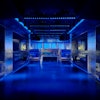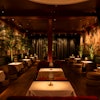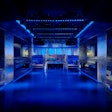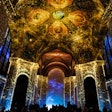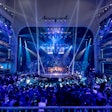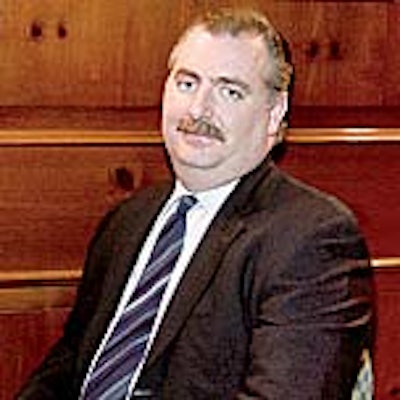
Title: Managing Director
What he plans: When German-based trade show company Hannover Fairs decided to bring an spin-off of its CeBIT show in Hanover, Germany—the largest technology trade show in the world—Dineen was the trade show veteran they chose to run the event.
Staff: 12
Career path: Dineen worked for trade show company H.A. Bruno—now owned by CMP—for 15 years, was one of the founders of PC Expo. In 2001, he founded his own show, the Disaster Recovery and Business Continuity Expo.
Age: 43
Favorite magazines: Information Week, Harvard Business Review, Sporting News, Business Week
Favorite hors d'oeuvres: Palmiers
Where he/she grew up: Eastchester, New York
Where he lives: Huntington, New York
How long has Hannover Fairs planned to bring CeBIT to the U.S.?
CeBIT Hannover had been sold out for quite a few years, and the American market is something that companies like to think they can play in. With the technology market on the downswing over the last few years, they thought it was a good time to come in and invest in the future.
They thought it was better to come in when it was on its way down?
We have a long-term picture of investing in the marketplace. It wasn't like we needed to come in and hit it big right away. We'd done some research with the major exhibiting companies and major technology manufacturers, asking them what they'd be looking for if a new show came into town. It seemed like we were matching up well.
Why did you decide to bring it to New York?
That's where the audience is if you're talking about Fortune 500 enterprise-type companies. And their needs were not being met at the current shows. These shows are very good events—they weren't just concentrating on the quality attendee. And as budgets were getting tighter, exhibitors were spending less money and they were looking for something more focused. So when we made the commitment to do an enterprise-type event, instead of going to the West Coast where the exhibitors are, we figured we'd concentrate on the audience. So the exhibitors came here instead.
How do CeBIT's attendees differ from PC Expo's?
We don't go after the small business or the consumer market at all. We strictly go after the medium- to large-sized companies. We're looking at management to senior management, senior executives and C.E.O.-level people.
How long did it take to plan and bring the show from Germany to New York?
They announced the show in March 2002 at CeBIT Hannover, and at that point I was basically the only person at CeBIT America. I commuted to and lived in Princeton [where the home office for Hannover Fairs USA is located] for a few months and had to find a staff and an office in New York. In August we were somewhat solidified in this office with a staff. Then it was two to three months of surveys and studies and conversations, five months in getting it running, and then work-slash-planning through the rest of the year. Year two is actually more important because we've set the boundaries, we've said what we were going to do, and for the most part we've pulled it off. Now we have to make it stronger and bring more of the right attendees to the show.
How were the expectations for the first year?
Expectations were high because the challenge was that a lot of the attendees aren't familiar with CeBIT. The market still wasn't coming back, while the exhibitors knew CeBIT, they still were making decisions based on money and the marketplace, and it was a difficult position to be in for the technology trade show. The CeBIT name opened doors to a lot of conversations that might not have taken place if we had not had that name, but we still had to go through the same processes and prove ourselves.
Now that we've gone through the first year, the level of expectation is probably the same, because while the brand name got us to a point and the show itself was done well, we had a much harder time with some of the major exhibitors than we thought. We did bring the quality we said we were going to bring. Now we're refining that to bring a few more of the brand-name or larger, traditional exhibitors who do drive the audience.
How have trade shows changed since you started?
They went from being about the business, to being events and mass-marketing and then back to being business again.
How has technology affected the way you plan events?
Technology has made it easier. There's self-registration now instead of waiting on long lines. There are downloadable directories, beaming stations so you can take your PDA and connect and get the entire directory and all the exhibitor lists so you don't need a printed directory. But the end result is information, education and visibility. That premise doesn't change. It's just how the technology, even at non-technology shows, has made it more easily used, received or garnered.
—Suzanne Ito
Posted 05.19.04
Photo by Anna Persson for BiZBash.
This Q&A originally appeared in our newspaper, the BiZBash Event Style Reporter.
What he plans: When German-based trade show company Hannover Fairs decided to bring an spin-off of its CeBIT show in Hanover, Germany—the largest technology trade show in the world—Dineen was the trade show veteran they chose to run the event.
Staff: 12
Career path: Dineen worked for trade show company H.A. Bruno—now owned by CMP—for 15 years, was one of the founders of PC Expo. In 2001, he founded his own show, the Disaster Recovery and Business Continuity Expo.
Age: 43
Favorite magazines: Information Week, Harvard Business Review, Sporting News, Business Week
Favorite hors d'oeuvres: Palmiers
Where he/she grew up: Eastchester, New York
Where he lives: Huntington, New York
How long has Hannover Fairs planned to bring CeBIT to the U.S.?
CeBIT Hannover had been sold out for quite a few years, and the American market is something that companies like to think they can play in. With the technology market on the downswing over the last few years, they thought it was a good time to come in and invest in the future.
They thought it was better to come in when it was on its way down?
We have a long-term picture of investing in the marketplace. It wasn't like we needed to come in and hit it big right away. We'd done some research with the major exhibiting companies and major technology manufacturers, asking them what they'd be looking for if a new show came into town. It seemed like we were matching up well.
Why did you decide to bring it to New York?
That's where the audience is if you're talking about Fortune 500 enterprise-type companies. And their needs were not being met at the current shows. These shows are very good events—they weren't just concentrating on the quality attendee. And as budgets were getting tighter, exhibitors were spending less money and they were looking for something more focused. So when we made the commitment to do an enterprise-type event, instead of going to the West Coast where the exhibitors are, we figured we'd concentrate on the audience. So the exhibitors came here instead.
How do CeBIT's attendees differ from PC Expo's?
We don't go after the small business or the consumer market at all. We strictly go after the medium- to large-sized companies. We're looking at management to senior management, senior executives and C.E.O.-level people.
How long did it take to plan and bring the show from Germany to New York?
They announced the show in March 2002 at CeBIT Hannover, and at that point I was basically the only person at CeBIT America. I commuted to and lived in Princeton [where the home office for Hannover Fairs USA is located] for a few months and had to find a staff and an office in New York. In August we were somewhat solidified in this office with a staff. Then it was two to three months of surveys and studies and conversations, five months in getting it running, and then work-slash-planning through the rest of the year. Year two is actually more important because we've set the boundaries, we've said what we were going to do, and for the most part we've pulled it off. Now we have to make it stronger and bring more of the right attendees to the show.
How were the expectations for the first year?
Expectations were high because the challenge was that a lot of the attendees aren't familiar with CeBIT. The market still wasn't coming back, while the exhibitors knew CeBIT, they still were making decisions based on money and the marketplace, and it was a difficult position to be in for the technology trade show. The CeBIT name opened doors to a lot of conversations that might not have taken place if we had not had that name, but we still had to go through the same processes and prove ourselves.
Now that we've gone through the first year, the level of expectation is probably the same, because while the brand name got us to a point and the show itself was done well, we had a much harder time with some of the major exhibitors than we thought. We did bring the quality we said we were going to bring. Now we're refining that to bring a few more of the brand-name or larger, traditional exhibitors who do drive the audience.
How have trade shows changed since you started?
They went from being about the business, to being events and mass-marketing and then back to being business again.
How has technology affected the way you plan events?
Technology has made it easier. There's self-registration now instead of waiting on long lines. There are downloadable directories, beaming stations so you can take your PDA and connect and get the entire directory and all the exhibitor lists so you don't need a printed directory. But the end result is information, education and visibility. That premise doesn't change. It's just how the technology, even at non-technology shows, has made it more easily used, received or garnered.
—Suzanne Ito
Posted 05.19.04
Photo by Anna Persson for BiZBash.
This Q&A originally appeared in our newspaper, the BiZBash Event Style Reporter.


